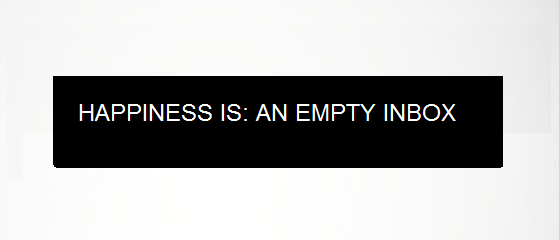Before sorting them out, I was the proud owner of nine email accounts. One for work, one for school, one for freelance work, one as my personal email, two for a project I was working on with a friend, one that came with an online notebook, one with an embarrassing nickname (because we all have one of those) and one I had completely forgotten about. If you’re anything like me, not logging in to your email accounts because the unread count is in the high hundreds, this is for you. The following steps will help you clean up your email inboxes for good. A short warning: When I cleaned up my inboxes, it took me a whole day to do it. It’s tedious and slow work, but once you’ve completed the steps below and stuck to the principles, you never have to do it again.
How to Organize your Email Inboxes?
- Create an overview of all your email accounts
- Go from easiest to clean up to hardest
- Delete the email accounts you no longer use
- Unsubscribe from newsletters
- Use the email inbox as an inbox, not a storage place
Get an overview of all the accounts you have
As said, I had completely forgotten about at least one of my email accounts. Before you begin with the actual cleanup, list all the email accounts you have. That includes shared inboxes and work email accounts. Even if you might not technically be the owner of an email account, as long as it’s your responsibility to maintain it, include it in your cleanup.
Go from easiest to clean up to hardest
Sort through the accounts that are easier to sort through first. Leave the accounts that are going to take the longest for last.
Start with the accounts that are to be deleted
Most of the emails that spam up our inboxes aren’t actually important. They are newsletters, advertisements, alerts, and just plain spam. That’s why it’s a good idea to start with the accounts that you’re going to delete anyway. Don’t bother with unsubscribing to newsletters and alerts with these accounts. Only focus on the emails that are important.
- Start by filtering your emails according to where they’re from.
- Take care of open to-do’s that you can take care of.
- Forward emails that you still need to your main accounts.
- Gather all emails that contain login data to online accounts in a folder.
- Transfer emails and attachments you still need to your hard drive.
- Use the emails with the account login data to log in to your online accounts and either delete them or reassign them to your main email account.
- Delete the email account.
Do the same for email accounts you still use
- Start by filtering your emails according to where they’re from.
- Unsubscribe from all newsletters and alert you aren’t actively reading.
- Delete all emails you don’t need to open to know that you can delete them.
- Create a folder to transfer all emails with login data into.
I suggest keeping folders, to file emails, to a minimum. If you need a backup folder to store emails you might need again to look something up or because you’re required to keep them, I suggest only creating two folders at most: a sent and a received one. You’ll be using the filter/search function anyway when looking up a specific email in the future, so there is no need to further sort. That is, of course, assuming that you aren’t required by company regulations to adhere to a different system. Obviously, you might also be using your email accounts more actively for work, and need different project folders. Whatever works best for you. But for personal email accounts, I recommend the bare minimum of extra folders or none at all. Why? It is advised to stick to a minimum of storage items in order to keep a house clutter-free. Because once you start packing things out of view, they accumulate. Whereas when there is no place to hide things, we tend to only keep what matters. The same is true for your inbox. Once you start filing away emails in folders you’ll lose an overview of what you filed away and your inbox starts to clutter again.
- Sort through the emails you have to read to decide what to do with them. Only keep emails that are still to-do’s in your inbox. All others, either delete, once taken care of or file.
- Do the same for all the emails you’ve sent.
- Again, use the emails with the login data to log into your online accounts you don’t need anymore and delete them.
- Delete the login emails once done with them.
- Clean out the spam folder.
- Permanently delete all emails you just deleted.
Ideally, you should be left with only the accounts you’re actively using. There should only be to-do emails in your inbox/sent folder. All emails that need to be kept for reference reasons should be filed away.
Principles for Keeping Inboxes Clean
- Delete all email accounts you don’t actively use.
- Make it easy to log in to your email accounts.
- Unsubscribe from all newsletters/alerts, you don’t actively read.
- Check and clean out all your inboxes daily. Ideally, first thing in the morning.
- Keep folders for email filing to an absolute minimum.
- Only keep to-dos in inbox/sent folder. File emails that are dealt with, which you only keep for reference reasons.
- Delete emails that are done and serve no future use right away.
- Make it a habit to clean out the spam and deleted folder every time before you sign out.
- If you check your emails on your phone, make sure to clean out your actual account too. Emails you delete on your phone often aren’t deleted in the account itself and therefore accumulate.
If you follow these steps and make a habit of daily cleaning up your email accounts, you will never again feel overwhelmed by the state of your inbox. Cleaning up personal email accounts daily hardly takes any time at all since most of us don’t receive a ton of new emails within a day. As to your work email; taking care of your emails first thing in the morning allows you to plan your day better. This way you won’t miss a deadline because you didn’t see an email.

